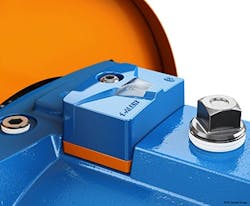Developments in sensors, coupled with the Industrial Internet of Things (IIoT), are enabling fast and economical monitoring of equipment such as motors, drives and pumps. Moreover, such advances are fostering the emergence of edge processing — i.e., analyzing and interpreting data right where they are gathered.
While operating companies can’t eliminate risk of equipment issues, affordable Internet of Things (IoT) monitoring can provide “cheap insurance,” stresses Jonas Spoorendonk, digital portfolio manager, motors and generators, ABB, Ladenburg, Germany.
“A customer does exactly what it did before, but in an easier and more affordable way. Reliability is improved and both maintenance and safety optimized,” he says.
As an example, Spoorendonk points to the success of a smart sensor condition-monitoring pilot completed in July at Transcontinental Advanced Coatings (TAC), Wrexham, U.K. That company, which also has a facility in Matthews, N.C., makes precision coated papers, films and specialty substrates for use with digital imaging technologies.
TAC’s pilot project aimed at enhancing the existing monthly manual maintenance regime on a critical oxidizer process that cleans air before its release to the atmosphere.
ABB Ability smart sensors fitted to the motors and mounted bearings of the oxidizer’s two fans collect and analyze performance data. Exceeding pre-defined limits for parameters such as temperature and vibration sets off system alarms.
Based on the success of the pilot, TAC is launching a second phase of the project; it will use multiple smart sensors to remotely monitor the motors and bearings throughout a process, together with up to four Bluetooth gateways connecting with ABB’s secure server. Ultimately, the company will roll out the technology across its global platform.
“If you look at our offerings until quite recently — and those of everybody else — we’ve been looking at individual assets such as electric motors. The big thing now, however, is the digital powertrain, i.e., monitoring assets that belong together [Figure 1]. Transcontinental has a classic radial fan set-up. There we monitored three assets: the motor and the two bearings of the fan. We also monitored the ambient temperature of the room in which the fans were installed. Altogether, that’s a good example of one powertrain,” he explains. “Readers should understand that there can be many different powertrains with users choosing which assets form part of theirs,” he adds.
Figure 1. There’s an increasing focus on more-cohesive checking of assets that belong together. Source: ABB.
The natural evolution of this approach is the use of artificial intelligence [AI] machine learning to provide more insights into a powertrain’s workings and to identify correlations and anomalies, Spoorendonk believes.
Driving Change
Drives will play a key role, believes Steve Meyer, Georgetown, Texas-based regional sales manager, Danfoss Drives, North America, because they can provide important information about the pumps or other equipment connected to them. Danfoss already offers a drive sensor (Figure 2); it will get additional IIoT features this fall.
Figure 2. Drives soon may function as edge servers. Source: Danfoss.
“We see drive intelligence on the move, enhanced by the ability to embed more powerful processors at low incremental cost. The question then becomes, what opportunities will more processor power enable? Today, the trend is towards increasing the functionality of drives to eliminate the need for PLCs [programmable logic controllers]. Soon increased data processing capability and connectivity will make it possible for a drive to work as an edge server,” he says.
Industry is re-inventing itself to take advantage of smart manufacturing methods, a process that will require at least the next ten years to implement, he reckons. “Already users can buy low-cost sensors with powerful embedded processors capable of carrying out edge analytics. The local analytics can be focused on machine condition monitoring at the point of use. At the same time, this data can then be served up to a plant server or to the cloud. Then, true AI processing can be used to look at every aspect of a plant operation.”
Investing in an IIoT-focused approach promises two compelling benefits, notes Meyer.
First, it can significantly reduce maintenance costs. “The advanced analytics lead from traditional scheduled maintenance to intelligent, predictive maintenance. So, if you think of a chemical plant as a large asset with a $50-million/yr maintenance budget, industry studies suggest that it is possible to halve this by investing in an IIoT strategy. That’s $25 million/yr saved on the maintenance side alone.”
Second, the same investment becomes a bridge to making data available from local sensors to a server running broader AI programs. “The goal here is to optimize the overall process. If you get a 3% next gain in production at a $1-billion plant, that can increase its value by $30,000,000,” he says.
Having intelligent drives with built-in IIoT capabilities act as edge servers for overall AI plant analysis is a low-cost, low-risk strategy along the way to IIoT adoption, he believes. “Effectively the whole IIoT solution is therefore embedded into what we regard as an existing control system. You can do predictive analytics, edge analytics and process optimization — the whole shooting match.”
Data Dividends
For its part, Nidec Motor Corp., St. Louis, is focusing on its stand-alone Forecyte remote monitoring platform. This uses battery-powered wireless sensors to measure equipment vibration and temperature, enabling users to predict imminent equipment failure and to better operate and maintain equipment. Nidec is developing sensors for other inputs such as current, pressure and flow.
Forecyte gathers continuous real-time data — with the collection interval customizable for each individual sensor — and visualizes equipment health. The data sent wirelessly to a gateway then go through either ethernet, wi-fi or cellular networks to a cloud portal for aggregation, storage, analysis and visualization using a web interface.
“The best use is generating advance warnings so customers can plan when they will carry out maintenance rather than waiting for an unplanned downtime which might last days. We’ve even seen the benefits of this in our own plants,” says Pranesh Rao, Nidec’s director of new products – electronics and software.
As an example, he cites last year’s very first installation of Nidec’s vibration/temperature sensor at a company that uses very long conveyor belts. The gearbox in one of the two motors driving the main conveyor belt was prone to failure. Past breakdowns had caused two-day shutdowns, each resulting in more than $150,000 in lost production.
“It took just two days for the sensor using its temperature inputs to notice that one gearbox was consistently running 25°C hotter than the other. It turned out that this gearbox took more of the load at start-up — it wasn’t being shared equally,” he explains.
The problem could have been solved with variable speed drives or some other way of load sharing but, as Rao points out, this would have been expensive.
Instead, because the data collected by the sensor gave the company at least a week’s warning of a potential failure, it could order a spare gearbox in advance and plan for its installation (which only took two hours) once the original failed. This, in turn, eliminated the huge costs incurred by two days of process downtime.
“The margins are so thin for many companies these days that they are happy to pursue this sort of ‘reactive’ strategy. It’s simply a huge benefit for them to be forewarned and have the replacement part ready for installation,” notes Rao.
Nidec’s easily scalable vibration sensors detect 60–70% of the most common problems, Rao estimates. A company shouldn’t necessarily strive to capture the other 30–40%, he says. “It can be done, but does it make sense in every application? We have seen customers get great benefits even with limited sensing power which is simple to use, deploy and cost-effective.”
Indeed, don’t go overboard with onboard data collection, Rao cautions.
First, it often is more-cost-effective to collect only basic data necessary to warn of a pending problem and then, at that point, to do more-detailed analysis with the substantially more expensive equipment traditionally used in route-based monitoring.
Second, a similar caveat applies to edge processing as advances occur in such diagnostic intelligence capabilities. “Here too, collecting and processing only what you need allows the edge intelligence to be deployed more cost-effectively,” Rao notes.
“It’s really very important to understand that there is a lot of value to be gained by doing very simple things — getting the low hanging fruit. In years to come you might get a specific time and date for an equipment failure — but not yet, despite what some vendors say,” he emphasizes.
Making Success Simple
Simplicity is key at this stage of the technology take-up — especially for the traditionally slow-adopting chemical industry, agrees Dan Kernan, executive director product management and technology, ITT Goulds Pumps, Seneca Falls, N.Y.
“That’s why we made the i-ALERT equipment health monitor so simple. It’s battery powered, can be glued to a pump or motor and uses edge capabilities to detect waveform variations in them. This data is then extracted to the free mobile app and it’s all up and running for $300–400,” he explains.
Figure 3. Compact device provides a simple way to monitor pump condition. Source: ITT Goulds Pumps.
The returns often are rapid and straightforward. For example, one customer’s monthly maintenance walk rounds have been cut by 30–50%, freeing up engineering staff for other duties, he notes.
Another chemical company was struggling with a pump that failed every 6–12 months. An i-ALERT monitor (Figure 3) found two events in its two weeks of operation. The culprit turned out to be a storage tank with a low-level alarm set so low that it was damaging the pumps. Raising the low-level alarm setting solved the problem.
“Remember that you have this insight 24/7. Also, these examples illustrate how much low hanging fruit is out there,” adds Kernan.
ITT Goulds Pumps now is in the trial phase of integrating more devices plantwide — moving into the multiple hundreds.
“We are finding that customers are now wanting to integrate all this information in one location, most usually the data historian,” he says.
Many are using the company’s i-ALERT Gateway to achieve this. Launched in April, the gateway configures all sensors in range, allowing users to remotely and continuously monitor rotating equipment to identify and troubleshoot problems before they become serious.
However, many chemical companies are struggling to determine the most important data within the massive amount gathered, believes Kernan. “I’m seeing lots of new jobs with ‘digital transformation’ in the title and hearing much talk of data lakes and data warehouses while they come up to speed,” he notes.
Once a company overcomes this triage challenge, it then can look at the process itself because this is just as important as machine health data in identifying root causes.
“I see AI and machine learning combining data and making recommendations. Perhaps we will see the situation where AI rather than operators makes the decision to manipulate process variables.”
However, for now, speed and simplicity are key to leveraging the low-hanging fruit, he concludes. “That’s the most important activity in the coming years. Later on, more integration will start to happen.”
Seán Ottewell is Chemical Processing's Editor at Large. You can email him at [email protected].






